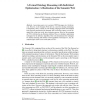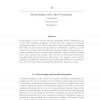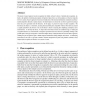73 search results - page 8 / 15 » Second-Order Description Logics: Semantics, Motivation, and ... |
LICS
1994
IEEE
14 years 16 days ago
1994
IEEE
The theory of cut-free sequent proofs has been used to motivate and justify the design of a number of logic programming languages. Two such languages, Prolog and its linear logic ...
WISE
2005
Springer
14 years 2 months ago
2005
Springer
Abstract. Answering a query over a group of RDF data pages is a trivial process. However, in the Semantic Web, there is a need for ontology technology. Consequently, OWL, a family ...
DLOG
2003
13 years 9 months ago
2003
In this chapter, we are concerned with the relationship between Description Logics and other formalisms, regardless of whether they were designed for knowledge representation issu...
COOPIS
2002
IEEE
14 years 1 months ago
2002
IEEE
The Semantic Web is a vision of the next generation Web, in which semantic markup will make Web resources more accessible to automatic processes. Description Logics (DLs) are of cr...
LOGCOM
2002
13 years 8 months ago
2002
We present a logical approach to plan recognition that builds on Kautz's theory of keyhole plan recognition, defined as the problem of inferring descriptions of high-level pl...



